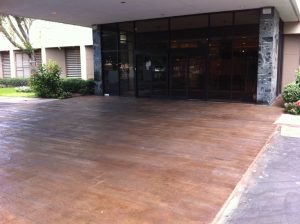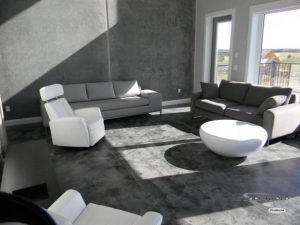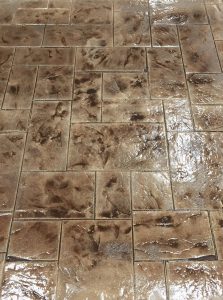Overcome Common Application Challenges of Concrete Color Staining
As an applicator, coloring may be daunting or even overwhelming. Many installers can expertly and comfortably install the various material applications – such as stamping an overlay, installing a smooth floor or even a simple broom finish – however, staining concrete is another story. Even the greatest installers can struggle with coloring applications, which are not just technical, but highly personalized for each project and client.
The good news – you don’t need to channel Monet or Van Gough to get achieve a stellar color stain. Follow these application tips to overcome the most common coloring challenges and get the look you really want.
Applicator Tip 1: Limit Your Color Choices and Combinations
Think about eating out for a moment. When you have a short and sweet menu, it’s easy to choose a meal and move on. When you have five pages covering five different cuisines, your selection is more difficult and takes much more time. Same goes for the color selection with your flooring. When you have 20 or more colors to choose from, you can easily get lost in the choices available.
Most projects will utilize the same popular color combinations, such as earth tones, reds and grays. It’s not so common to come across a job requiring wild blues, greens or yellows. Pick a couple color combinations that you expect to install regularly, and create some nice samples with them. The combinations are usually a pair of colors: your “base color,” which is the lighter of the two, and your “highlight color,” which is typically the darker.
Keeping samples of these popular color combos will help seal the deal for your customers. Plus, you won’t have to worry about running short on the job, as you will most likely have these colors on hand from previous projects. If you do run into a project with wild color combinations, you can refer customers to the color chart at that time.
Applicator Tip 2: Staining Stamped Textures
The natural stone appearance of stained stamped textures is among the most popular looks for flooring right now. It’s very easy to achieve this appearance with Super-Krete’s water-based Color Stains.
Unlike other coloring products, Super-Krete’s line doesn’t require any antiquing agents when applying the stains. Water is the only thing you’ll need to get the natural appearance. Just follow these steps:
- Apply a Solid Base Color – Take your lighter color and apply a solid base coat. Achieve this by spraying down the Color Stain onto the surface with a pump up sprayer and broom in the base color in a circular motion, with a soft bristle broom. The circular motion will aid in eliminating obvious broom marks. It also ensures you get nice even coverage of the stain. Allow the base color to dry completely before moving to the next step.
- Apply a Highlight Color – Don’t let the term “highlight color” confuse you. The highlight color is actually the darker of the two. This is the step that really brings the natural look to the finish.
To start, make sure you have a pump-up sprayer filled with your highlight color. You will also need a pump-up sprayer filled with just water. Apply a light mist of water on the surface. Immediately after spraying the water, spray down your highlight color on the area with water. Immediately after applying the highlight color, spray another mist of water on top of the highlight color.
The water you sprayed down initially allows the stain to flow into the low areas, as opposed to drying as soon as it hits the surface. Following the highlight color with additional mist of water forces the color off of the high areas and gives you a unique natural stone appearance. You can go light or heavy with the highlight color depending on the look you want to achieve. I always recommend going light at first and working towards a darker look. You can always apply another coat – but you can’t “un-apply” a coat. Also make sure you seal your project for protection.
Applicator Tip #3: Staining Smooth Surfaces
Applying Color Stain to a smooth surface requires an entirely different method than staining a textured surface. Textures allow for the stains to flow and create a natural appearance. The same method on a smooth surface would result in puddling.
Keep in mind that while a surface is smooth, it must still be porous in order for the stains to penetrate. Even when staining a micro topping, you must sand the surface with a 60 or 80-grit screen to create a porous surface. Do not attempt to apply water-based stains onto polished concrete.
Other common application tips for smooth surfaces include:
- Avoid putting too much stain on the floor at once. Since you don’t have textures to help with the flow and design of the stain, you want to only apply enough stain that the surface is willing to accept.
- Avoid using the traditional pump-up sprayer for this application, as it will spray down too much material. You want a finely atomized mist when going over smooth surfaces, whether it be by an airbrush or an inexpensive gooseneck spray bottle. This allows the stain to begin drying on impact.
- As you are spraying the color stain down, work the stain into the surface using a microfiber mop. Use circular motions with the mop to eliminate any obvious swirl marks and create a more organic appearance. Depending on the porosity of the surface, the stain will absorb into the surface like an acid stain would look, leaving you with a natural stained appearance with light and dark areas. If a darker appearance or finish is desired, simply apply more coats in the same fashion until you reach your desired darkness level. Multiple colors can be used simultaneously to achieve marble or mottling effects.
- As always, be sure to seal your end result for protection with the appropriate sealer of choice.










